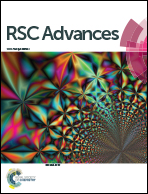A facile strategy for the synthesis of monodispersed W17O47 nanoneedles†
Abstract
We present a facile one-pot wet chemical strategy for the synthesis of monodispersed W17O47 nanoneedles, of which the synthetic conditions and photothermal properties are systematically investigated. By modulating experimental conditions such as the ratio of solvent, the dose of sulfur powder and the reaction time, uniform W17O47 nanoneedles with an aspect ratio larger than 10 are obtained. These hydrophobic W17O47 nanoneedles are subsequently transferred into aqueous solution by coating with amphiphilic polyvinylpyrrolidone (PVP) for photothermal imaging applications. The results suggest that these monodispersed nanoneedles have potential for photothermal detection and photothermal therapy.


 Please wait while we load your content...
Please wait while we load your content...